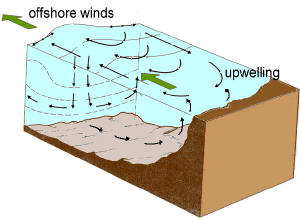|
Temperature and density can define a water mass. Warmer water
can hold more salt, and colder water holds less salt. Salt water is more
dense than fresh water of the same temperature. The salt water will
layer itself below the fresh water. Warm water is less dense than cold
water. So cold water will layer under warm water. Add the combination of
different amounts of salt and different temperature and you have a
layering effect in the water column. The world’s oceans are a
three-dimensional nightmare of layers of different water masses that can
move in different directions.
Bottom topography can act as a barrier to water masses already in
motion. If a cold saline water mass is moving along the bottom and
"hits" a mountain it would be forced upwards. This is one form
of upwelling. This would displace the water masses above it, causing
lots of movement.
|

Water masses move in different directions
|